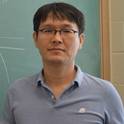Solid state chemistry has produced a plethora of materials with properties not found in nature. For example, high-temperature superconductivity in cuprates is drastically different from the superconductivity of naturally occurring metals and alloys and is frequently referred to as unconventional. Unconventional superconductivity is also found in other synthetic compounds, such as iron-based and heavy-fermion superconductors. Here, we report compelling evidence of unconventional nodal superconductivity in synthetic samples of Rh17S15 (Tc = 5.4 K), which is also found in nature as the mineral miassite. We investigated the temperature-dependent variation of the London penetration depth Δλ(T) and the disorder evolution of the critical superconducting temperature Tc and the upper critical field Hc2(T) in single crystalline Rh17S15. We found a T − linear temperature variation of Δλ(T) below 0.3Tc, which is consistent with the presence of nodal lines in the superconducting gap of Rh17S15. The nodal character of the superconducting state is supported by the observed suppression of Tc and Hc2(T) in samples with a controlled level of non-magnetic disorder introduced by 2.5 MeV electron irradiation. We propose a nodal sign-changing superconducting gap in the A1g irreducible representation, which preserves the cubic symmetry of the crystal and is in excellent agreement with the derived superfluid density. To the best of our knowledge, this establishes miassite as the only mineral known so far that reveals unconventional superconductivity in its clean synthetic form, though it is unlikely that it is present in natural crystals because of unavoidable impurities that quickly destroy nodal superconductivity.
Available at: http://works.bepress.com/hyunsoo-kim/33/

U.S. Department of Energy, Grant FR CNRS 3618